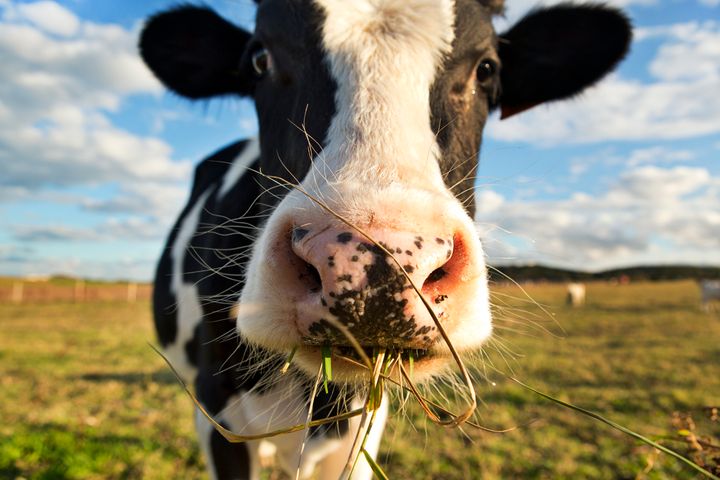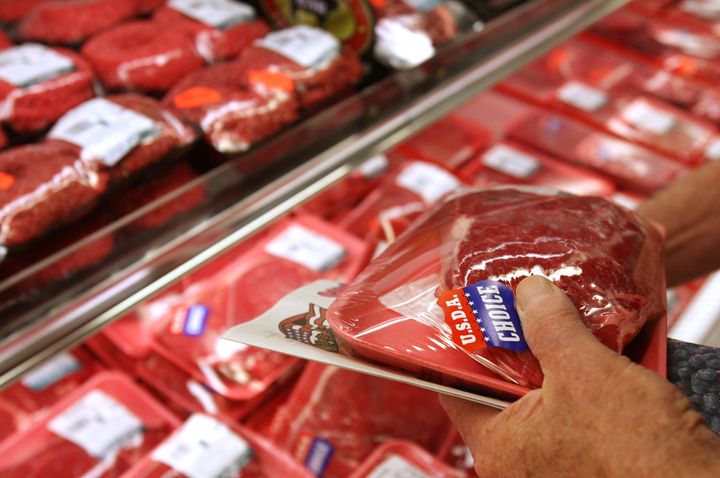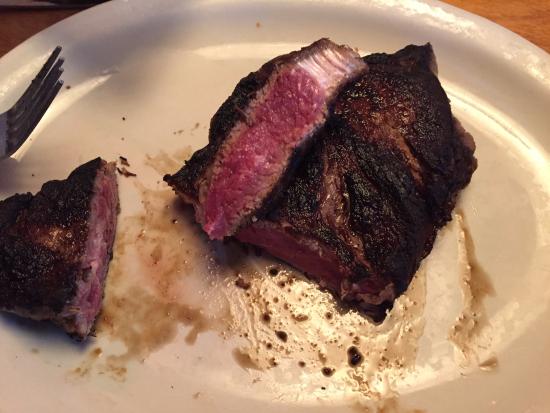eternalreign06
Chi-town Bred
Again..
That 'Blood' In Your Meat Isn't What You Think It Is | HuffPost
That ‘Blood’ In Your Meat Isn’t What You Think It Is
It’s not exactly pleasant, though.
By Suzy Strutner

Chung Sung-Jun via Getty Images
As it turns out, that “blood” in your steak isn’t blood at all.
It’s myoglobin, the protein that delivers oxygen to an animal’s muscles. This protein turns red when meat is cut, or exposed to air. Heating the protein turns it a darker color. Rare meat isn’t “bloody,” it is just cooked to a lower temperature.
There’s a reason some meats are darker than others.
Myoglobin delivers oxygen to muscle tissues. Animals with more active muscle tissues, as well as older animals, both have meat with more myoglobin, Jeffrey Savell, a distinguished professor of Meat Science at Texas A&M University, told HuffPost.
That’s why veal, which is the meat from a baby calf, is much lighter in color than steak from a full-grown cow ― its muscles haven’t been activated as much as the older cows. It’s also why darker meat is found on turkey legs (where there’s more active muscle tissue) and lighter meat is found in the breasts.

Tony C French via Getty Images
The freshest meat is actually purple.
A fresh-cut slab of cow’s meat is actually purplish in color, Savell says. Exposure to oxygen during the packing process turns it the cherry-red tone we’ve come to associate with freshness.
“This pigment is of major importance, since it represents the bright red color desired by purchasers,” reads “Lawrie’s Meat Science,” one of the tentpole books for students and professionals in the meat industry. Some producers have even gone so far as to treat their meat with carbon dioxide gas in order to lock in this red color far past its normal lifespan.
But brown does NOT mean it’s bad.
After a few days in a grocery store display case, myoglobin molecules naturally oxidize and the meat eventually turns brown, Savell says. It may look less appealing, but it isn’t any less safe to eat.
“Brown meat doesn’t mean it’s bad,” Savell said. “But [grocery stores] will discount it, mark it down. If you buy brown meat, just be sure to cook it right away, because it’s likely already been out there for three or four days.”

Bloomberg via Getty Images
A meat’s color can tell you how it was cooked.
Meat changes color depending on its internal temperature at the time of cooking. According to “Lawrie’s Meat Science,” red meat that reaches an internal temperature of 140 degrees Fahrenheit during cooking will have a bright red interior, while red meat cooked to 140 to 158 degrees will be pink. Anything hotter than that should turn the meat grayish-brown.
Keep in mind, however, that the U.S. Department of Food and Agriculture recommends cooking steak to an internal temperature of at least 145 degrees Fahrenheit and letting it rest for three minutes to kill nasty bacteria that could make you sick.
That 'Blood' In Your Meat Isn't What You Think It Is | HuffPost
That ‘Blood’ In Your Meat Isn’t What You Think It Is
It’s not exactly pleasant, though.
By Suzy Strutner

Chung Sung-Jun via Getty Images
1.6k
49
As it turns out, that “blood” in your steak isn’t blood at all.
It’s myoglobin, the protein that delivers oxygen to an animal’s muscles. This protein turns red when meat is cut, or exposed to air. Heating the protein turns it a darker color. Rare meat isn’t “bloody,” it is just cooked to a lower temperature.
There’s a reason some meats are darker than others.
Myoglobin delivers oxygen to muscle tissues. Animals with more active muscle tissues, as well as older animals, both have meat with more myoglobin, Jeffrey Savell, a distinguished professor of Meat Science at Texas A&M University, told HuffPost.
That’s why veal, which is the meat from a baby calf, is much lighter in color than steak from a full-grown cow ― its muscles haven’t been activated as much as the older cows. It’s also why darker meat is found on turkey legs (where there’s more active muscle tissue) and lighter meat is found in the breasts.

Tony C French via Getty Images
The freshest meat is actually purple.
A fresh-cut slab of cow’s meat is actually purplish in color, Savell says. Exposure to oxygen during the packing process turns it the cherry-red tone we’ve come to associate with freshness.
“This pigment is of major importance, since it represents the bright red color desired by purchasers,” reads “Lawrie’s Meat Science,” one of the tentpole books for students and professionals in the meat industry. Some producers have even gone so far as to treat their meat with carbon dioxide gas in order to lock in this red color far past its normal lifespan.
But brown does NOT mean it’s bad.
After a few days in a grocery store display case, myoglobin molecules naturally oxidize and the meat eventually turns brown, Savell says. It may look less appealing, but it isn’t any less safe to eat.
“Brown meat doesn’t mean it’s bad,” Savell said. “But [grocery stores] will discount it, mark it down. If you buy brown meat, just be sure to cook it right away, because it’s likely already been out there for three or four days.”

Bloomberg via Getty Images
A meat’s color can tell you how it was cooked.
Meat changes color depending on its internal temperature at the time of cooking. According to “Lawrie’s Meat Science,” red meat that reaches an internal temperature of 140 degrees Fahrenheit during cooking will have a bright red interior, while red meat cooked to 140 to 158 degrees will be pink. Anything hotter than that should turn the meat grayish-brown.
Keep in mind, however, that the U.S. Department of Food and Agriculture recommends cooking steak to an internal temperature of at least 145 degrees Fahrenheit and letting it rest for three minutes to kill nasty bacteria that could make you sick.




 Another one of Rule's classics
Another one of Rule's classics

 . fukk I look like eating pink unsalted flesh?
. fukk I look like eating pink unsalted flesh? 




